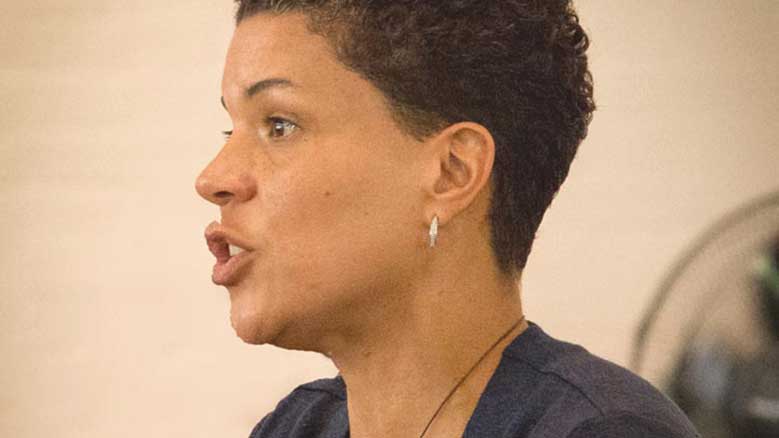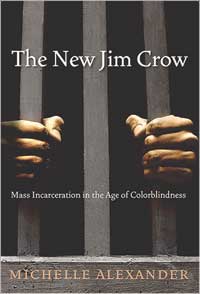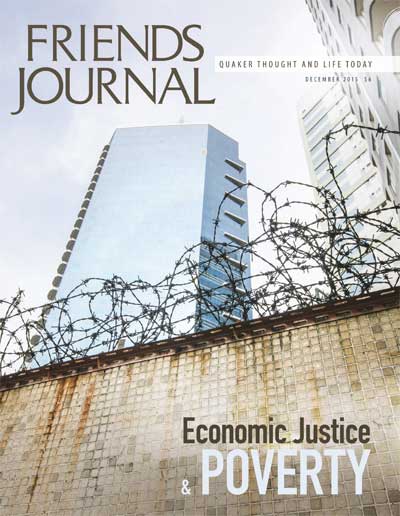
Quakers Connect as a Movement Builds
On April 28, as protests continued on the streets of Baltimore in response to the violent death of Freddie Gray in police custody, just over 100 people gathered on the bucolic campus of Pendle Hill, a Quaker study center in Wallingford, Pennsylvania, for a five-day conference on “Ending Mass Incarceration and the New Jim Crow.” The contrasting settings were lost on no one; yet change felt ripe.
Freddie Gray’s death was the most recent case of violence and oppression faced by so many young black men caught in the country’s lethal criminal justice system. But unlike most cases that go largely ignored and forgotten by the media, the African American community in Baltimore decided, like a growing number of black communities around the country, that enough was enough. They took to the streets, and CNN and other media outlets followed. What is known as the #BlackLivesMatter movement has emerged as communities of color demand justice. And despite the lack of direct connection between mass incarceration and the #BlackLivesMatter movement in the media, the two are intimately linked.
 Underlying the U.S. criminal justice system is a method of social control designed to oppress people of color, an outgrowth of this country’s history of racism and slavery. As Michelle Alexander writes in her now classic book The New Jim Crow: Mass Incarceration in the Age of Colorblindness, the current system “is not—as many argue—just a symptom of poverty or poor choices, but rather evidence of a new racial caste system at work,” one that, like Jim Crow, “operates as a tightly networked system of laws, policies, customs and institutions that operate collectively to ensure the subordinate status of a group defined largely by race.” Historically, black lives don’t matter, and it is no more clearly evident than through the disproportionate effects of mass incarceration on communities of color.
Underlying the U.S. criminal justice system is a method of social control designed to oppress people of color, an outgrowth of this country’s history of racism and slavery. As Michelle Alexander writes in her now classic book The New Jim Crow: Mass Incarceration in the Age of Colorblindness, the current system “is not—as many argue—just a symptom of poverty or poor choices, but rather evidence of a new racial caste system at work,” one that, like Jim Crow, “operates as a tightly networked system of laws, policies, customs and institutions that operate collectively to ensure the subordinate status of a group defined largely by race.” Historically, black lives don’t matter, and it is no more clearly evident than through the disproportionate effects of mass incarceration on communities of color.
Yet most of those attending the conference at Pendle Hill that weekend were not African American, or people of color; most were white women, roughly between the ages of 40 and 75. This is, of course, not surprising, and as a demographic is fairly representative. Liberal Quaker homogeneity has been the source of a good deal of angst among Quakers, rooted in a sincere leading to work for justice and equality. The question, however, remains: How could such a group, so seemingly removed from those most directly affected by mass incarceration, and potentially benefiting from its existence, hope to transform the criminal justice system? How should Quakers address issues of race, both systemically and in our communities?
John Meyer, the education coordinator at Pendle Hill, designed the conference with the intention of bringing together historically segregated communities: namely, communities of color and majority white Quaker ones. “We live in a white supremacist society,” Meyer said, “and Quakers have never really confronted that reality.” Meyer, who has had a longtime interest in issues of race and racism, hosted the event with the intention of creating an opportunity for Quakers to connect with those leading current civil rights efforts, resulting in real, skillful action. He hopes that this current movement to end mass incarceration would be a starting point for Quakers to finally confront the systemic racism that underlies American culture, including our religious communities.
Of course, the conference was not inspired by Meyer’s interest alone; Quakers around the country have become increasingly involved in work to end mass incarceration. Michelle Alexander’s book and subsequent work to build the movement has taken hold, with a growing number of Quaker meetings and even yearly meetings across the country selecting The New Jim Crow for their adult education programs.
The swelling interest in ending mass incarceration was most evident at the Friends General Conference (FGC) Gathering in summer 2014. American Friends Service Committee (AFSC) organized a variety of events on the topic of mass incarceration, including a workshop titled “Journey through Our Criminal Justice System” led by staff Lewis Webb and Scilla Wahrhaftig (a former staff member and an active Quaker) and a plenary address by Laura Magnani, director of AFSC’s Bay Area Healing Justice Program in California, on the issue of solitary confinement. These events inspired a small group of Friends to gather during meal times to think together about what to do with this growing leading to confront the new Jim Crow.
During a final afternoon interest session that week, Lewis Webb led a discussion to determine next steps for moving this energy forward. What emerged was the Quaker Network to End Mass Incarceration, organized by a steering committee dedicated to facilitating coordination and cooperation between Quakers around the country. This committee, on which John Meyer serves as the recording clerk, helped to organize the Pendle Hill conference, and many on the steering committee attended. Those involved in the planning hoped that it would serve as a launching point for the network, an opportunity to solidify a nationwide Quaker commitment to end mass incarceration.
Diane Butler, a Quaker living in South Carolina, served as the committee’s clerk through September of this year. She was one of the most inspired and active individuals calling for more coordinated action during the FGC Gathering that week. I first met Diane while representing AFSC during a yearly meeting gathering of Friends in South Carolina. Though she had found a safe haven of progressive thought and spirituality in her Quaker community, she still attends the local Baptist church. Her identity as an African American woman has always kept her straddling two worlds.
When I spoke with her at the beginning of the conference, she expressed some concern. No one, it seemed, was addressing the racism within our own communities, racism that might be inhibiting Quakers’ ability to fully engage with this issue. As the conference continued, people, including Diane, were able to express similar concerns more openly, but they were not central. Even the low number of African American Quakers in attendance was never mentioned, though most of those who spoke of their personal experience with mass incarceration were people of color.
The conference attempted to strike a very difficult balance—that of addressing the issue of racism without devolving into an opportunity to wallow in guilt and remain stuck in paralysis. Quakers have often had a hard time discussing race without becoming disempowered. As Lewis Webb told me, he gets “frustrated by Quakers’ need to apologize for their whiteness.” He acknowledged that it is important to understand and point out white privilege, but guilt about that privilege only leads to inaction. This conference de-emphasized the emotions around personal racism and instead focused on steps that could be taken to dismantle it, systemically.
According to Matthew Pillischer, another of the conference’s main organizers and the director of Broken On All Sides, a film on mass incarceration, white people should switch the conversation from asking “what is wrong with me and what must I give up?” to “what do I have to gain from fighting racism and ending mass incarceration?” At the core of the current racial caste is economics: those with power pitting races against one another in order to maintain the status quo. The first step in fighting oppression is simply building power by joining forces, even if those first steps are tense and difficult.
Pillischer, who has been to many conferences on the topic, sharing his film and working with organizers to help build the movement, said that this was one of the largest conferences of its kind, featuring the voices of those directly affected by the issues. By not only telling their stories but also sharing information about how to support their new organizations, people have started to transform the system. By creating a conference that focuses on the personal experiences of those directly affected and currently working for change, we can fully understand what we all—both personally and as a society—have to gain by recognizing the humanity of others. The passion and strength of the presenters would add so much to our communities and our world. These were not just storytellers; they were leaders that we all desperately need. They were calling us to action.
This conference was, indeed, action-oriented. In fact, it was so jam-packed with speakers and events that there was barely time to process each presentation. While there were ample opportunities to think about the issue in a variety of ways—through the lens of immigration, gender, and geography—there wasn’t much time to acknowledge the deep emotional wounds incurred by the system, or how the reality of the system’s violence might affect the participants. There were small reflection groups each afternoon, but most people used that one free hour to sleep or simply spend some time alone.
It was, however, a uniquely Quaker conference in its attempt to integrate the spiritual with the emotional and intellectual components of the issue. This was nowhere more apparent than in the opening ceremony, a program designed to ground the conference in faith and Spirit.
But it did not begin in a perhaps conventionally somber Quaker fashion. Instead we were thrust into the emotional realities of our broken criminal justice system with a hip-hop performance by the artist Jasiri X. Jasiri is an artist and an activist who works with young people across the city of Pittsburgh to build new leadership interested in addressing issues of police brutality and oppressive systems of power. He met John Meyer while at the White Privilege Conference, and was invited to perform at this conference with the promise of meeting Michelle Alexander. Jasiri’s work is confrontational, raw, and powerful. His performance left no doubt in anyone’s mind about the integral role that race plays in the structure and implementation of justice in this country.
After several more performances, the opening ceremony then encouraged the participants to add their voices through a call and response by the Baptist minister and Quaker supporter, Mary Wade. She asked the crowd a number of questions, starting with “what is mass incarceration?” and others that considered the physical, emotional, and spiritual effects of our broken criminal justice system. Attendees responded with answers both personal and general, concrete and abstract, intellectual and emotional. Finally, she asked, “Who will end mass incarceration?” With the crowd passionately shouting, “We will!” the conference began with a commitment to action.
The following morning, Michelle Alexander kicked off the main topic of the conference with a bold demand: nonviolent revolution. During her interview with J. Jondhi Harrell, the founder and executive director of the Center for Returning Citizens, and Daniel Hunter, the author of an organizing manual called Building a Movement to End the New Jim Crow, Alexander emphasized the important role that faith communities have in addressing mass incarceration. As was stated by many that week, the dehumanization of people of color in this country is a spiritual problem, and one that must be addressed with powerful love and a complete transformation of the system. That transformation must begin by standing up for justice: taking to the streets and strategically using nonviolent tactics to dismantle a corrupt system.
Later that day, members from the #BlackLivesMatter movement in Ferguson and Baltimore spoke in a panel discussion about their experience of the movement’s beginnings and subsequent growth. Ebony Williams, a young woman from St. Louis, Missouri, who has been very involved in the movement, spoke passionately about her frustrations with the calls for nonviolence. Why should the young protesters be nonviolent, she asked, when nonviolence has never been effective in the past? Why must she reject forceful tactics, she asked, when so many people in her community and around the country, including herself, are terrorized by the police on a daily basis? Her challenging and impassioned questions encouraged everyone to consider the privilege of beliefs, and the importance of continually developing a collaborative, effective strategy for creating real, lasting change. How can we create a society that learns to see and value every one of us, even those who have committed violent crime?
The answer may be complete transformation. Having served time in prison, Harrell understands firsthand the new “caste system” that so many find themselves stuck in as part of the criminal justice system. As a self-described Rastafarian-Quaker, Harrell believes in the power of a personal connection with the Divine, and feels a resonance between his own spirituality and the collective spirituality of Quaker worship. For several years he has found community at Germantown Meeting in Philadelphia.
Harrell’s organization, the Center for Returning Citizens, provides services for men and women returning from prison, struggling to navigate a society that treats them as if they are still criminals and places barriers against their engaging fully in society. His hope is to create an entire network of returning citizens establishing and supporting vibrant communities around the city of Philadelphia. It is more than a simple band-aid; it seeks to transform and empower our society.
There is some good news in what can seem at times a daunting movement: the prison population seems to be going down in several states, and many politicians are acknowledging mass incarceration as a major problem in the United States. However, we were warned by Alexander and others that these political solutions have the potential to be co-opted by a system that is heavily influenced by big business. While it is exciting and hopeful that so many in Washington are now turning their attention to the issue of mass incarceration, there is fear that the current system will simply be replaced by new, more cost effective technology that will sidestep confronting our country’s legacy of racism.
However, Tila Neguse, a lobbyist with Friends Committee on National Legislation on the issue of mass incarceration, presented what is and can be done in the federal system. She showed several videos of traditionally conservative politicians, whom one might presume are interested in reducing prison numbers for purely economic reasons, speaking passionately to the problem of racial discrimination within the system. The solutions to the issue of race and oppression in this country will likely be as complex as the problem itself.
How will Quakers be part of the solution? The conference participants were encouraged to spend time considering strategies and tools for moving forward. Hunter, the author of the organizing guide, is a local activist and facilitator. He led a discussion on direct action and movement building, and emphasized the importance of focus: bringing down just one “pillar of injustice” as a means of poking holes in oppressive systems and catalyzing change. Lucy Duncan from AFSC also presented an effective organizing model that can be used in faith communities, specifically. The model involves forming small groups that work together to support already existing local social justice movements. Those small groups meet on a regular basis to reflect upon their experience of supporting social change and, as a result, become support for one another, helping to establish a more sustainable commitment to grassroots work.
Bringing this rich experience together, AFSC’s Magnani gave a final presentation, titled “Avoiding Pitfalls in Dismantling the Beast, a Cautionary Talk.” She laid out some questions to consider when moving forward, including “what does accountability look like?” and “does the proposal increase the dignity and autonomy of persons so that they can move toward wholeness?” Staying committed to seeing and honoring the dignity of each human being will require constant re-examination and evaluation. It will take time and it may involve some mistakes. But we must act. Magnani’s final presentation was cautionary but was supported by a deep current of hope. The solutions to such a complex issue will not be simple, she said, but we can take heart in the joy we feel in seeing the humanity in others and, by extension, ourselves.
By the end of the conference, the participants had formed a small community and had built bonds that would inspire each individual to take action. The final session invited everyone to stand and state how and what he or she would do after leaving the conference. By encouraging everyone to state intentions out loud, and watch as they were written up on screen, the exercise evoked a strong sense of accountability, as well as a kind of power—the power to create change.
The conference may have been far removed from the everyday struggles of racism and oppression in this country, but it created the conditions of learning, love, and personal growth—a great basis for any movement. It provided the tools and the experience to transform our broken system with powerful love.






“Why should the young protesters be nonviolent, she asked, when nonviolence has never been effective in the past?” This statement is of course false. Read Chenowth and Stephan’s Why Civil Resistance Works which indicates that non-violent action is much more effective than violent action. Particularly in this case where the State has the power of firearms, police (even military if necessary), courts, prisons, money, and so on, confronting racial injustices has to be non-violent. One of the greatest examples of non-violent success is Martin Luther King, Jr’s civil rights movement that ended de jure segregation. The status quo would love us to be violent because then they can squash us with impunity.